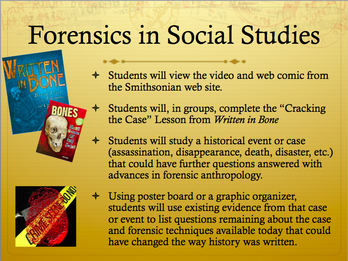2.4 Literacy strategies
Candidates collaborate with classroom teachers to reinforce a wide variety of reading instructional strategies to ensure P-12 students are able to create meaning from text.
2010 ALA/AASL Standards for Initial Preparation of School Librarians
|
Reading is the first step to acquiring knowledge in any field. In Young Adult Literature, SLM 504, our task was to create a project that integrated literature across curriculum. Our group chose to tackle the topic forensics, taken from the Maryland state standards in 7th grade science. We located materials and learning activities to link the topic across disciplines: English, Art, Science, and Social Studies. We also presented links to popular culture connecting the topic to student’s lives outside of school. The lesson plan lists the applicable standards and objectives for each content area and an explanation of suggested classroom reading instructional strategies, and includes an annotated bibliography of suggested materials.
|

All of our activities are designed with Bloom’s Taxonomy in mind. Middle school students tend to be fascinated with the odd, gory, and mysterious. Reading related high interest fiction and nonfiction, writing a case file, solving a mystery, creating artwork, interviewing a professional, and considering an alternate history all help students reach critical thinking levels. I feel the interview with the professional really caps the experience and allows students to see the possibility of their own career – or decide this is not the field for them. The collaboration between multiple staff members allowed for a wider sharing of ideas and perspective, and I feel resulted in a much more engaging and creative project than could have been accomplished by one teacher alone.
Collaboration between disciplines and coordination by the school library media specialist benefits and increases student learning by helping students form more concrete connections. It benefits staff by opening access to a wide variety of resources and tools. I was intimidated by the amount of coordination required by this project at first, but I learned that a well-run initial meeting, frequent email communications, and collaborative group mates can make a project like this run smoothly. In a school setting, a successful project should then be promoted to encourage other staff to try similar collaborative efforts. Seeing others accomplish great things can inspire collaboration in other areas of the school.
Collaboration between disciplines and coordination by the school library media specialist benefits and increases student learning by helping students form more concrete connections. It benefits staff by opening access to a wide variety of resources and tools. I was intimidated by the amount of coordination required by this project at first, but I learned that a well-run initial meeting, frequent email communications, and collaborative group mates can make a project like this run smoothly. In a school setting, a successful project should then be promoted to encourage other staff to try similar collaborative efforts. Seeing others accomplish great things can inspire collaboration in other areas of the school.

This portfolio and the artifacts contained herein by Amy Soldavini are licensed under a Creative Commons Attribution-NonCommercial-ShareAlike 3.0 Unported License |
Revised July 2013
